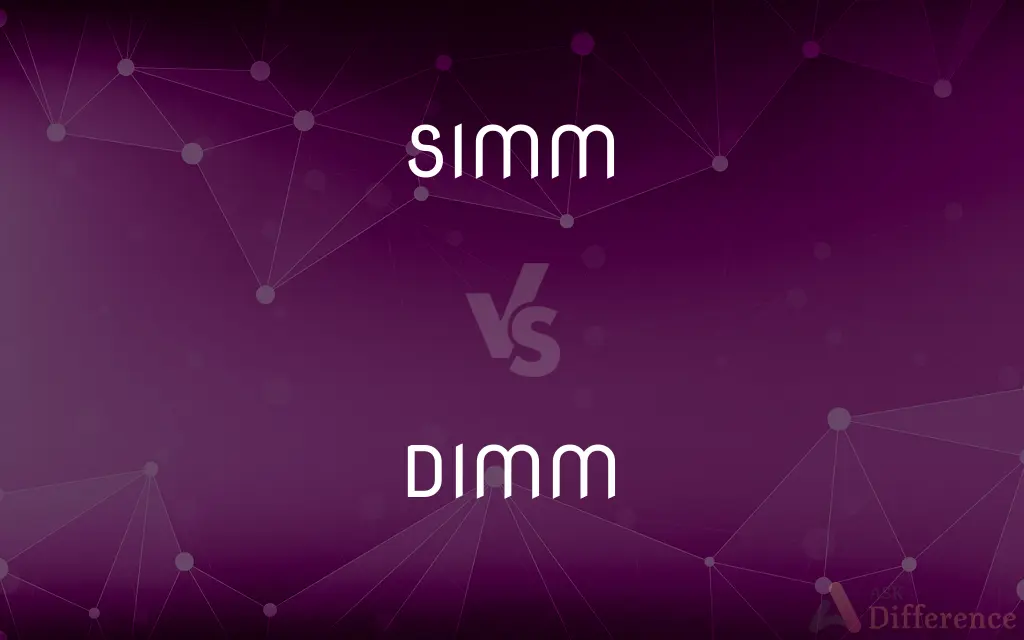SIMM vs. DIMM — What's the Difference?
By Tayyaba Rehman — Published on January 4, 2024
SIMM (Single In-line Memory Module) has pins on one side only, while DIMM (Dual In-line Memory Module) has pins on both sides for more bandwidth.

Difference Between SIMM and DIMM
Table of Contents
ADVERTISEMENT
Key Differences
SIMMs are older memory modules with a 32-bit data path, primarily used in computers from the late 1980s to the mid-1990s. DIMMs, which succeeded SIMMs, provide a 64-bit data path, making them faster and more suitable for modern computing needs. While a SIMM must be installed in pairs to match the 64-bit standard of motherboards, a single DIMM can be used.
The physical difference is notable; SIMMs have pins on only one side of the module, which actually connect to the same contacts on the other side, effectively doubling the connection. DIMMs have separate electrical contacts on each side of the module, doubling the available data path and increasing performance.
In terms of compatibility, SIMMs are not interchangeable with DIMMs due to their different designs and electrical configurations. Computers designed for SIMMs will not have the necessary slots for DIMMs and vice versa. DIMMs also come in various types, such as SDRAM, DDR, DDR2, DDR3, and DDR4, each with improvements in speed and power efficiency over their predecessors.
Installation of SIMMs requires inserting the module at an angle and then tilting it upright to lock into place, often in adjacent slots to achieve the necessary bus width. DIMM slots are designed for vertical insertion without the need to pair the modules, simplifying the upgrade process and allowing for greater flexibility.
The evolution from SIMM to DIMM is part of the broader trend of increasing computer performance. As processors became faster, the need for quicker memory access grew, necessitating the shift to DIMMs, which could handle more data at once and operate at higher speeds than SIMMs.
ADVERTISEMENT
Comparison Chart
Data Path
32-bit
64-bit
Pin Configuration
Pins on one side connect to both sides
Separate pins on both sides
Installation
Installed in pairs
Installed individually
Speed and Performance
Lower speed and performance
Higher speed and performance
Types
Mostly FPM and EDO
Includes SDRAM, DDR, DDR2, DDR3, DDR4
Compare with Definitions
SIMM
SIMM is an older type of memory module.
My vintage computer still uses 30-pin SIMMs.
DIMM
DIMM allows for a 64-bit data path.
With DIMMs, you don't need to worry about installing memory in pairs.
SIMM
SIMM was commonly used in 80s and 90s computers.
I found some old SIMMs while refurbishing a 90s-era computer.
DIMM
DIMM offers higher performance than older memory types.
Upgrading to faster DIMMs can significantly improve system performance.
SIMM
SIMM provides a 32-bit data path.
We had to install two 16-bit SIMMs to get the full 32-bit data width.
DIMM
DIMMs are installed individually, not in pairs.
I just added an extra DIMM to upgrade my computer's memory.
SIMM
SIMM has identical contacts on both sides of the module.
This SIMM can be inserted either way due to its symmetrical contacts.
DIMM
DIMM is a modern memory module with separate contacts on each side.
My new motherboard requires DDR4 DIMMs.
SIMM
SIMMs need to be installed in matching pairs.
To upgrade the PC, you must insert two identical SIMMs.
DIMM
DIMM types include DDR, DDR2, DDR3, and DDR4.
Make sure your DIMM type matches the motherboard's specifications.
Common Curiosities
What does DIMM stand for?
DIMM stands for Dual In-line Memory Module.
Are DIMMs backward compatible with SIMMs?
No, DIMMs are not compatible with SIMM slots.
Can I use SIMMs in a modern computer?
Modern computers typically do not support SIMMs.
What does SIMM stand for?
SIMM stands for Single In-line Memory Module.
How do I know if my computer needs SIMM or DIMM?
Check the computer’s motherboard specifications for memory requirements.
Is there a physical difference between SIMMs and DIMMs?
Yes, SIMMs have pins on one side, while DIMMs have separate contacts on each side.
Do I need to install DIMMs in pairs?
No, DIMMs do not need to be installed in pairs, unlike SIMMs.
What's faster, SIMM or DIMM?
DIMMs are generally faster than SIMMs due to their wider data paths and newer technology.
Are SIMMs still manufactured?
SIMMs are largely obsolete and are no longer manufactured for mainstream use.
Can DIMMs be used in any motherboard?
DIMMs must be compatible with the motherboard's specific type and generation (e.g., DDR4).
What is the main benefit of using DIMMs over SIMMs?
DIMMs offer a wider 64-bit data path and higher performance.
Were SIMMs ever used in laptops?
SIMMs were not commonly used in laptops, which typically used smaller form-factor memory.
What are the common types of DIMMs available today?
Common types of DIMMs include DDR, DDR2, DDR3, and DDR4.
Can I mix different types of DIMMs?
No, different types of DIMMs (like DDR3 and DDR4) should not be mixed.
What type of memory module do servers use?
Servers typically use DIMMs, often ECC (Error-Correcting Code) DIMMs for added reliability.
Share Your Discovery

Previous Comparison
DBMS vs. RDBMS
Next Comparison
ALTER Command in SQL vs. UPDATE Command in SQLAuthor Spotlight
Written by
Tayyaba RehmanTayyaba Rehman is a distinguished writer, currently serving as a primary contributor to askdifference.com. As a researcher in semantics and etymology, Tayyaba's passion for the complexity of languages and their distinctions has found a perfect home on the platform. Tayyaba delves into the intricacies of language, distinguishing between commonly confused words and phrases, thereby providing clarity for readers worldwide.
















































